Modeling the Paleodistribution of Baboons and Vervets
Natalie O’Shea, Anthropology
Faculty Advisor: Dr. Eric Delson
Project Website: Modeling the Paleodistribution of Baboons and Vervets
NML Award: The Data Analysis and Visualization Award (May 2019)

Early modern human demography and biogeography are related to a wide range of important issues in modern human origins research, from the earliest appearance of markers of symbolic culture in the archaeological record to the global dispersal of Homo sapiens by at least 60 thousand years ago. However, our ability to discern ancient patterns of population structure from the fossil record and patterns of variation in extant populations is limited. Patterns of genetic and morphological variation in other widely-distributed, ecologically-flexible primates can provide useful insights into past human demographic and biogeographic changes. Baboons (genus Papio) and vervets (genus Chlorocebus) are broadly co-distributed with each other and human populations in woodland and savannah habitats across sub-Saharan Africa, making them good ecological model taxa for early modern human populations. This study will utilize recently developed species distribution modeling techniques to map the current and past distributions of baboons and vervets to identify regions in which populations of the earliest members of our species may have persisted through difficult climate conditions in Africa over the past 130 thousand years. Overall, the results of this work will provide a model for early modern human demography and biogeography and also expand our understanding of African faunal evolution more broadly.